Pichest Boonthomme - In Honor of My Teacher
20 years ago this man, renowned as a Thai Massage Instructor and practitioner influenced me and my path in a significant way
I was deeply saddened to recently learn of my Thai massage teacher’s passing in August of 2023. I would like to send my condolences to his family through the cyber ethers as I have no way to contact them. May Arjahn Pichest rest in peace.
อาจารย์พิเชษฐ์ หลับให้สบายนะครับ คิดถึงครับ
Learning of Pichest’s passing brought me a great sadness. This sadness stems from receiving so much from Pichest, yet being apart from him for almost 20 years now. I had longed to return to visit him once again, with my family, to enjoy his company, and his teachings, once more.
Upon learning this through an internet search that had me looking to see what people were posting about Pichest these days, I began to deeply reflect on my time with him. It was a pivotal time of my life, and upon reflection, I began to realize how significant his impact on me really was.
For this reason, I would like to tell the story now that I have never taken to writing down before. This is a story of what brought me to Thailand, what I found there, and what I brought home with me.
Learning Thai
In 2004, I had been practicing Thai massage for about 1 year. This practice accompanied what I had learned in my Shiatsu training, but I primarily performed one or the other. I had learned from Ohashi, a renowned master of shiatsu, but I was less well-versed in Thai massage as I had learned from one person, a friend, within less than 10 hours of training. I took what I learned, gave a session to the owner of a local bodywork clinic, and was hired.
Thai massage was not well known in the states and did not have much respect as a healing art. Many people referred to it as “thigh massage” either as a joke or out of ignorance.
Over time, I felt like if I were to continue practicing Thai massage that I would need to go to Thailand. I knew next to nothing about Thailand at the time and had never even thought of going there.
It was roughly mid-autumn of 2004 and I had a very vivid and moving dream. Within this dream I was being shown, from a very thick, ancient book, a series of hand drawn postures and positions in the Thai massage tradition (nuad Tai paen borarn). A master, my teacher, was showing me these positions and highlighting the relevance of what I was looking at.
As we paged through the book together I knew this was ancient knowledge that I was meant to absorb. As I awoke, I had a knowing that I must seek this out one way or another.
I began asking my friend who had initially taught me where I might go to learn in Thailand. “Chiang Mai” was what I was told. It’s a “softer style”. Bangkok style is “very hard”; ‘you’ll like it much better up in Chiang Mai’.
That’s all I needed to hear.
Next was to figure out how I was going to make it work financially to go away to Thailand for several weeks. This was not an easy task for me in 2004.
As I was pondering this, I was invited to attend a meditation with a roommate’s friend. Not knowing what I was getting into, I agreed to come along. There I met a Thai monk with whom I shared my plans to go to Thailand to learn the traditional massage and other traditional healing techniques. From there, he agreed to provide me with a crash course in Thai culture and language so that I could integrate with the Thai people in a respectful way and to help me find a place to stay at a nearby wat, or monastery.
Somehow, I can’t recall how, I came by a series of cassettes with Thai language lessons. From there I began to familiarize myself with the sounds of Thai, a tonal language. For a non-tonal language speaker this can be most perplexing!
For example, the words for “near” and “far” both sound like glai - one being an upward tone (near), the other being a downward tone, like the sound is falling away from you (far). Try asking for directions in a strange place and see how well your foreign (farang) mind does with that!
But I continued to study and prepared myself to become conversant in Thai. That was my goal.
Miraculously, I figured out a way to make it happen but I was going to be on a shoestring budget. I purchased my ticket (open-ended return for less than $450!) and began making plans for my departure.
Arjahn Sarayut (the Thai monk) really helped me out by calling ahead to a wat on the outskirts of Chiang Mai preceding my arrival, to arrange for me to stay in a monk’s cabin at Wat Umong until I arranged for where I would be studying.
Nestled into the foothills of Doi Suthep, the mountain flanking Chiang Mai to the west, is the ancient temple of Umong. I knew nothing of the temple, but when I arrived I was captivated by the grounds. I felt like I had arrived at a Jedi training facility amidst the bamboo and thick tree cover in all directions. I would arise early each morning to meditate, practice yoga and train capoeira in the open courtyard beside the pillar. I was in my element - training body, mind and spirit towards its full potential. My journey was in full swing.
Introduction to Pichest
These were the early days of the internet, especially in regards to studying Thai massage abroad. I had found one reliable web page that claimed to review all the available options for studying Thai massage in and around Chiang Mai, the capital of the northern kingdom of Lanna Tai (“Land of a Thousand Rice Fields”).
Lanna Tai had been assimilated into greater Siam, the kingdom of the lowlands from Bangkok (Krungtep) north, Ayuttaya, eventually known as Thailand. But they had their own traditions and related language of Lanna Thai as I would come to learn. The kingdom Lanna once extended north into Burma, Laos, and the southern tip of Yunnan Province, China.
As I was perusing this web page, I found marked by an asterisk at the bottom of the page, were all the “recommended Thai massage schools”. Oddly, all of the listed schools had the asterisk but one. This “school”, listed as “Pichest Boonthomme”, (the only individual on the list) stated, “Pichest teaches a spiritual approach to Thai massage”.
Right away, I knew where I had to go. Despite the lack of recommendation by this list, I knew Pichest was the teacher I had seen in my dream and this is who I would ultimately study with.
But first, I would obtain a certificate from a school legitimized by Western ways and thinking (for example, turning the sen [energetic lines of the body] into concepts relatable to Western physiology) as that might be recognized back in the US and allow me to continue to practice without being a “licensed massage therapist”.
I had also heard that Pichest would only accept students who had previous training in Thai massage, or who had learned a sequence elsewhere. So that emboldened me further to complete this initial course before seeking out my teacher.
I won’t say that was a waste of 3 weeks gaining that certificate as I learned a few things and made a number of friends there, but what I learned with Pichest would quickly eclipse and leave behind all I had learned in the conventional, modernized school.
Becoming a Student
I can still remember the day I called Pichest from a pay phone at the bus station. It was Friday afternoon. I had completed my certificate course and I was excited to begin with Pichest the following Monday. I had called him maybe 2 weeks prior to confirm that I could reach him and that he would accept me as his student once I finished at the institute of thai massage.
He picked up the phone and I asked to speak with Arjahn Pichest in Thai. He acknowledged it was he I was speaking to and laughed his characteristic laugh, probably for my Thai. I quickly confirmed that I could only speak a little Thai before we went on any further, but that I was ready to come to his class and learn from him. He laughed again, told me that was good, and proceeded to let me know what I needed to begin training with him - there was a list.
Something like… 9 incense sticks, 7 pieces of fruit, and 12 candles, or something like that. Honestly, I can’t recall, but may have it written down somewhere.
I had heard that Pichest made “strange requests of his students” but “not to worry” he ‘doesn’t do so past the first week’. Honestly, I respected what he was doing and could feel the importance in his work and the respect for where he believed his abilities came from. I couldn’t fully articulate this at the time, but I had a feeling of understanding where he was coming from when we had this first, somewhat lengthy exchange over the phone.
I was excited to be learning, excited to be starting with my teacher in just a few short days.
Invisible
One of the first lessons Pichest taught me was on self-importance. Although I didn’t go in expecting that it would be “all about me”, I was about to receive a lesson in humility.
Upon arriving Monday morning on the rot daeng (“red car”) I picked up at the South Gate, I carried in my basket of goods as an offering. I was told upon arrival that I would be directed by Pichest once we began as to where I would bring the offerings, then waited, somewhat anxiously, for class to begin.
Pichest called us together and, as I recall, we began the class by chanting the traditional homage to Dr. Shivago Komarpaj, the Indian doctor revered throughout Thailand as the bringer of knowledge in all ways of healing. Although I had learned this chant at ITM, I noticed that Pichest added in another shorter segment that was in homage to the “patron saint of Lanna Thai”, Kruba Srivichai, a locally revered monk, that we recited in the ancient Pali language.
Pichest then instructed another student to bring me back to the altar and to show me where I was to put my offerings never addressing me directly.
After his initial talk, Pichest began a demonstration on one of the students. I was keenly observing, wishing to get everything just right on the first go round. I was ready, if he were to ask me a question or call on me to demonstrate if I was paying attention or not.
After his demo, he instructed us all to pair up and practice what he’d shown us. I ended up with one of the senior students. He began by showing me, once more, what had been demonstrated by Pichest. Then he asked me if I would like to try it. Sure, that’s why I’m here, I thought.
I began doing what I thought I had been shown, but it seemed that my partner wasn’t sure I was doing it correctly. This went on for a bit until Pichest came around and spoke to the other student, not in Thai, but in his best English. He was speaking to him about me, in front of me, as if I wasn’t there. And he did so casually, almost humorously, ‘as if I was a joke’, I thought.
I could feel myself starting to become irritated with not being acknowledged. I was irritated with my partner who seemed equally disdainful of me and my abilities. I left class feeling dejected. ‘What am I doing here?’ I thought.
I came back for the second day, and it wasn’t much different. Still no direct engagement from Pichest.
I came back for the third day, and it wasn’t much different. But sometime during the afternoon practice, when I wasn’t thinking about it or even aware that he was nearby, Pichest came up close to me and touched me lightly on the shoulder as he spoke something quickly which altogether with his body language and how he was moving in told me that he was about to show me something. I moved aside to let hime in. Apparently, I had calmed down enough and was now ready to listen. This was the moment I had been waiting for.
Suffice to say, something lightened in me that day as I left class. I began to realize what Pichest had been doing, and although I still felt somewhat offended by it, I was beginning to accept it as a challenge to level up to my best as his student and to fully open up to what he had to offer me.
Patient Practice
I had since moved to a different wat, Wat Ku Kham, on the far east side of Chiang Mai, immediately adjacent to the bus station, as it was closest to my previous school. Because I had come to learn my way around from this location, I decided to remain here while studying with Pichest.
I would occasionally have conversations with phra arjahn, or master, of this temple who also spoke some English. He was an astrologer and offered to share some insights with me during a couple of our conversations. I have reflected on these insights over the years in light of my experiences and challenges. There was something poignant about certain things he shared with me that were all part of the experience of being in Thailand.
Additionally, I had a vision while there that a portal was closing on Thailand. That the access to an ancient past which had remained somewhat open for longer than in other parts of the world was now coming to a close. This was part of what called me here and why I needed to take in what I could now before this portal closed and pushed the past further into obscurity.
Interestingly, I had learned of a project being conducted by the monks while staying at this wat. It involved scanning the old palm leaf texts (what I had seen in my dream!) containing prayers as well as recipes for healing so they could be digitized. For me, this aligned with what I had seen about the portal closing.
To add to my daily practice, I had become acquainted with a large park not too far from the wat where I would head each morning at 4:30a. Stepping out onto the street I could quickly find a moped for hire to take me to the park. Once there, I’d find dozens if not hundreds of people walking the track, doing their exercises individually or in groups. At first, I did my own thing, but within a day or two I was befriended by a Thai man, an engineer, who spoke some English. He invited me to join him and his group which were practicing a series of exercises along to music, some of them with staffs. He called it “chi gung” but it was different from what I would later come to learn as chi gung.
At the same time, I had noticed a man and his wife practicing something different, alone and off to the side. They’d arrive on his motor bike, settle themselves, and begin a series of slow and deliberate martial arts type movements. I wandered over one day and watched them as they finished. He walked over to me smiling and asked where I was from. He, too, spoke some English and began to tell me about his tai chi and meditation practice. He was the first person to introduce me to standing meditation or xian xiong. I would come to learn from my teacher, Sam Tam, xian xiong was the predecessor of all chi gung and the basis for the powerful internal martial art, i chuan (“mind fist”). From that day forward, I would be joining them and following along, trying to learn the “long form” tai chi.
He told me that his teacher taught him that he must do it for 45 minutes a day in order to develop the strength and power this practice provides. Trusting in his tutelage, I would begin each day with 45 minutes of standing meditation before heading to the park to join he and his wife for some tai chi.
Little did I know, that I would be meeting my teacher, Sam Tam, in a little over a year, who would come to teach me xian xiong standing meditation, tai chi, various forms of chi gung, sword, fan, and stick, xing yi, ba gua and more.
Anchored in this daily morning practice, I would venture to Pichest’s home each morning at 9a to spend the day learning with him. I felt like I was in my element, learning and training all day long.
As time went by, I had the opportunity to absorb Pichest’s lessons as I listened and observed, as well as felt his touch. His ways were unlike anything I had experienced or heard of before. His method of sitting on or holding a point for several minutes was calming and deepening in a way that really touched me and it opened my physical body in a way like no other therapies I’d experienced.
However, I noticed how many Westerners who came through class, some of them quite “accomplished” in Thai massage with various fancy maneuvers in their toolkit, would quickly become confused or impatient with Pichest’s style of teaching and for that, they seemed to take little from it.
Even the rare Thai student often sat in confusion with what Pichest was attempting to relay to us. And the American or Australian or European that consistently went back to “the sequence” and how to specifically make the transitions or where exactly did this hand go or that hand go, would send Pichest railing into mocking their perpetual intellectual occupations. “Too much tinking! No feeling! Oh, farang, very bad, very bad.”
Chastising the farang (Westerner) for thinking too much and not allowing themselves to feel was a central piece to Pichest’s talks. He saw us as overly preoccupied with figuring things out and nearly clueless about being able to tune into what’s present right before us.
It had not occurred to me until recently how much Pichest’s teaching impacted me, or perhaps, awakened something within me that was not unlike him in many ways.
As I watched people come and go over weeks’ time, and Pichest continued to deliver his message and perform his art, I began to see more clearly what he was doing. It somehow all made sense to me, and during this time Pichest became more like a friend to me than a teacher.
I say this not out of disrespect, but by his actions and demeanor towards me. He showed me through his attention and his trust in me that he approved of how I was taking in his lessons.
It was maybe the middle of the 2nd week and I had seen maybe 1 or 2 people from the community come in for help. Most of his advanced students who had been there when I started had all moved on by now. The next person who came in for help was directed by Pichest to lie down. Then Pichest called me over and had me watch as he made his assessment. Then he instructed me on what to do. He left us alone as I went to work.
He came back maybe 30-40 minutes later to check on the progress, touching the area that had been too stiff; “tung” Pichest would exclaim. Noting improvement, he instructed me on where to move next.
He was inching me along, stretching me just slightly to see if I could follow his lead and execute on the positions and techniques he had been demonstrating for me.
As I passed this test, he would then take me to higher levels of challenge in which I was to be the assessor and executer of the technique.
Over time, a deep confidence built up within me to make assessments purely by touch, or “sensing” as Pichest liked to put it, and follow what what was unfolding in the body before me.
Needle in a Haystack
Pichest, while seated on the floor before us in a cross-legged position, would often make a hand movement into his lap and close his eyes to signal the act of meditation. He would do this while describing how difficult it can be to find the problem. Ban ha u ti nai, na? “Where is the problem, huh?
An American student had recently done a service for Pichest and his students, or so he thought, by creating a sequence book (the core of all Thai massage schools of the day) with names, when available, for each position, photos of the posture, and explicit instructions on where to place parts of the body and the sequence in which they’re to move into and out of each position, creating a flow from one to the next.
Pichest would regularly take the book, while giving his pre-class sermon, and slap it into his left hand with his right then act like he was throwing it over his shoulder and away from himself, stating, “Ah, you take book and throw it away. Book no good. Must have feeling.” Then shake his head and look down almost mumbling, “Farang, no understand…too many question, no answer.”
He would go on to say that it is very hard sometimes to find the problem, where the person is blocked or where the pain is coming from. Here he would indicate sitting in meditation, and just listening.
Making his toss the book away motion, once again, and slapping his hand into a palms up meditation pose within his lap, he would say, “it’s like needle in haystah. very hard find problem. must meditate (slaps hands into lap), must listen (closes eyes). go inside and see.”
Pichest would reiterate this over and over again how important it was to sit with oneself to gain this knowledge. That it was not discovered through rational thinking, but through a heart-centered consciousness.
I was not really aware, or I have simply forgotten over time, how much Pichest had influenced my approach to working with plants. For his approach to Thai massage is not unlike how I learn from plants and guide others to learn from and heal with plants.
Graduation
After several weeks of nonstop study, I had decided I needed a break. I had recently rented a moped for freedom of movement around town and I was now taking it out on the roads up into the mountains to explore the countryside. But now I just wanted to get away and be somewhere, and remain on foot for a week or so.
I headed up to Pai Pai town, a get away for foreigners, and for some, a party town, but I was there for some R&R. As it happened, during my several days’ stay in the village, the famous tsunami of December 2004 hit Sri Lanka, India, Thailand and elsewhere.
It was the day I was preparing to return to Chiang Mai. I can still remember it vividly. Even up north in the last bits of the Himalayas, far from the sea, I could feel the cinder block structure I was showering in shake once, twice, then a third time. Between each shake there was utter silence, even amongst the birds.
Then, after the final shake, and another pause of perhaps 20 or 30 seconds, the nearby women began chattering rapidly. I knew something had happened, but wasn’t sure what it was - I had never experienced an earthquake before.
I proceeded to get myself ready to go and completely forgot about it in the process of finding my truck ride back down the mountain (don’t ever sit near the tailgate on a windy mountain road; you’ll regret it).
By the time I was back in town, people were talking about the tsunami. Suddenly it clicked - that’s what I had felt that morning!
The young Thai woman speaking to me that evening declared with all seriousness that it was the Nagas. ‘We no longer vitiate them with offerings as we once did,’ she proclaimed. ‘We have lost our way and they have come to take what is theirs.’
I found it fascinating that she was raised with and carried this worldview, seeing the landscape as alive, the people in contract with the landscape, and with very real and direct consequences for breaking these contracts.
While away, I had visited a natural building and seed-saving community just north of Chiang Mai. A Thai man named Jo, who had learned to make adobes while living in Taos, was teaching local people how to make sustainable shelter with the raw materials of the land while growing food and saving seed. This was a project I was excited to participate in.
After an overnight visit, I was excited to return and lend a hand with their next project.
The following day I returned to Pichest’s class and upon entry he greeted me asking, with a great smile, “ah John, what you do next week?”. Before I could get the words out about my excitement over the adobe project, Pichest interjected, “ah, you go Phuket, go help people!”
Sorry… what‽ what are you talking about, Pichest‽‽‽
He then began to explain to me how a resort manager in Phuket had contacted him to come down and teach their now underemployed staff (no one was coming to the resort after the tsunami) a therapeutic style of Thai massage. Pichest, evidently, had been recommended, but he decided he could not go. So, instead, he aimed to send me in his stead.
“Pichest, have you ever been to the sea?” I asked. Shaking his head, smiling, then looking down, “No, mai cuy bai (I’ve never been)”. “Pichest, you have to go!” I exclaimed, excited for him at this opportunity to be somewhere he’d never been before.
He continued to explain to me how a large group of Americans was coming next week so he had to be there. I replied, quite rationally, “Why don’t I stay here and greet the group of Americans and you go down and teach the Thai people Thai massage!”
But Pichest’s mind had been made up. I was to go to Phuket in his stead. I was to represent him as an ambassador of his ancestral art form. I was to instruct the Thai people in this art form that they made their living doing day after day, undoubtedly, many of them much longer than I have.
I as humbled to say the least.
Pichest said to me, “You go to Phuket. You make the people happy.”
These were his primary instructions for me. Make people happy.
This was not easy for me to accept. I wanted to represent him with excellence and integrity, not just ‘make people happy’.
Pichest had bestowed upon me my graduation gift before I was to complete his final lesson. He had my utmost respect and I was to represent him to the best of my abilities.
He instructed me on how to set up the altar with incense, flowers, candles and fruit. I agreed and accepted. I would do as he told me.
Phuket
Upon arrival to the resort, I went straight to the beach to have a look for myself. “Someone had to have seen something coming,” I thought to myself.
As I looked down at the sand to see crabs scurrying about, birds in the trees nearby, above the manicured lawn, I wondered who would have noticed that something was amiss before the calamity struck?
The day I returned to Pichest’s class after the tsunami, I went out to lunch with my classmates. On our return walk I thought to ask the small group if anyone had had a dream about the tsunami beforehand, or perhaps had heard of someone who did. They barely responded to my inquiry and went back to their conversations.
There had been news circulating of another earthquake coming. I decided to visit the internet cafe that afternoon to check the news and see what I could find.
After reading George W. Bush’s declarative statement of some goofiness or other, I stumbled upon a story about a young man from Los Angeles who had been out at the beach when the tsunami hit. He quickly ran for the shore in shallow water, but before he could get far, the giant wave crashed upon him nearly drowning him, then again, and again, each time the water rising as it encroached further inland that he even considered jumping onto a car, then a building to escape the tsunami.
As I read this last part, my mind jolted and I suddenly recalled the dream I had had the night before leaving Pai Pai. It was almost the exact same experience this young man was articulating but even more extreme.
How had I not remembered this??
The power of the mind, soul, spirit to connect with the flow of life force between the material and immaterial realms is astonishing.
After taking in the scene at the beach, I was ready to get right to work as we would be starting our first session within a couple hours of arrival.
In addition to setting up the altar as Pichest had instructed me, and following the sequence of prayers we recited each day, I was committed to teaching as much of the class in Thai as possible.
No one asked me to do this, but I felt it was a way for me to extend my respect to the Thai people and their robust culture. Frankly, I couldn’t imagine simply showing up out of nowhere and teaching them about Thai massage completely in English. It felt wrong and out of context to me.
I could see that I gained the respect of several men within the class as I began to address them all in Thai, somewhat apologetically. However, the Thai people are very courteous and encouraging to farang who attempt to speak their language. So they aided me along the way. Undoubtedly, this made at least some of them “happy” so I was following Pichest’s instructions as well.
After 2+ days of teaching and challenging myself to speak in Thai, I was fried. At this point, almost 20 years later, I hardly remember what happened once we got started, but I know that I was able to impart something of significance to those people and that I did represent Pichest and the ancient tradition of Nuad Thai Paen Borarn to the best of my abilities.
Unfortunately, I was unable to see Pichest again before heading back to Arizona. I was to begin studying with Michael Moore in Bisbee, Arizona in less than 3 weeks and I needed to get back and get myself settled. Another major turn was just around the bend.
I always hoped that I would see Pichest once more in this lifetime. However, I trust that our paths will cross again one day and I can share my gratitude with him for all he passed along to me.
May your spirit burn brightly in the heavens above, Pichest.
Other articles on Pichest:
https://www.traditionalbodywork.com/pichest-boonthumme-the-legendary-thai-massage-master-from-thailand/
by Ananda A:
https://www.asianmedicinezone.com/thai-se-asia/pichest-boonthumme/



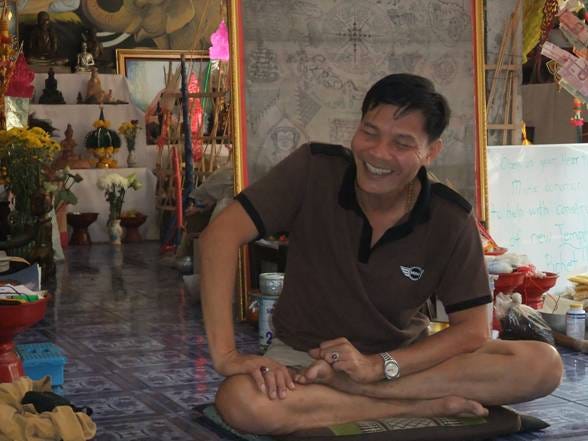
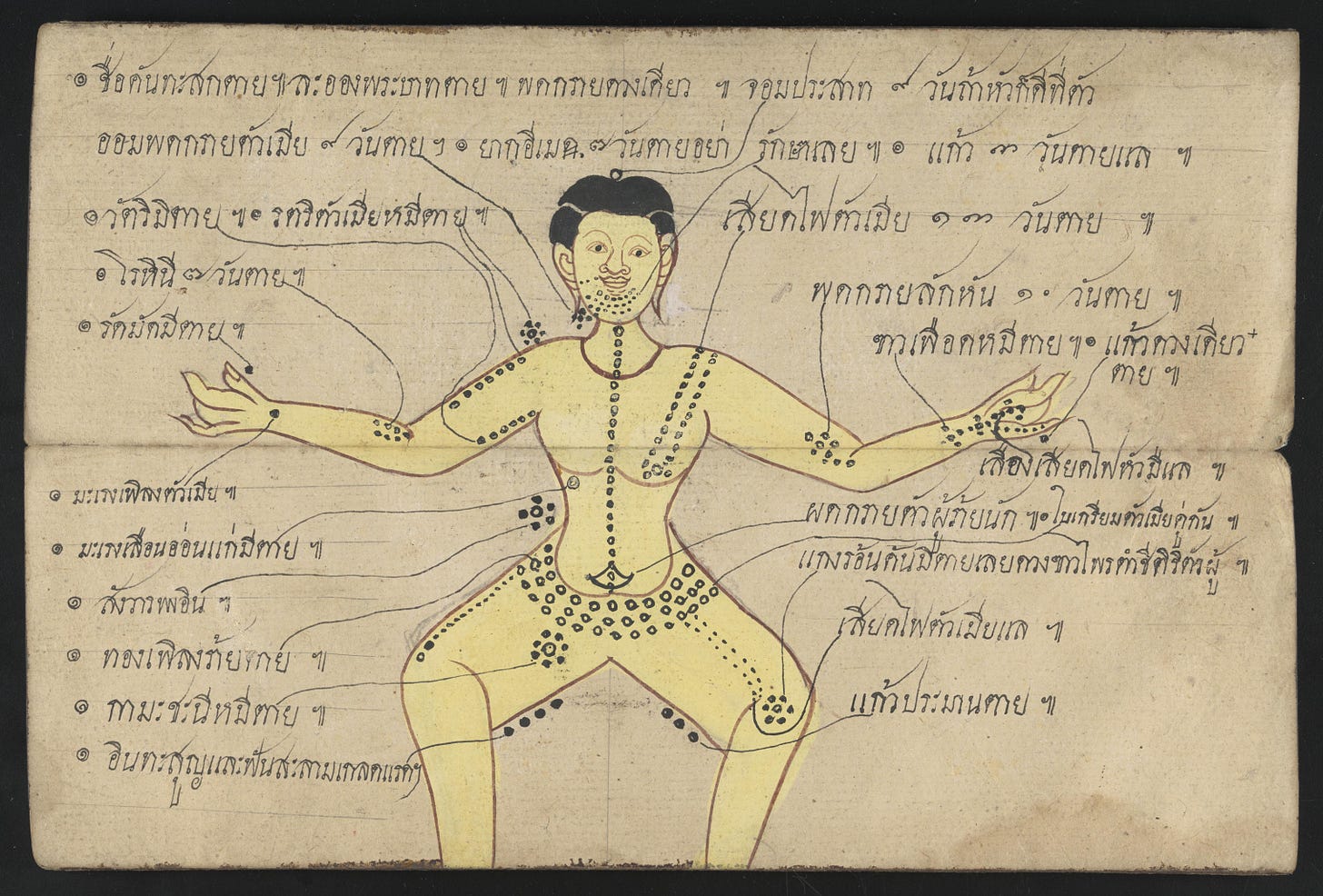


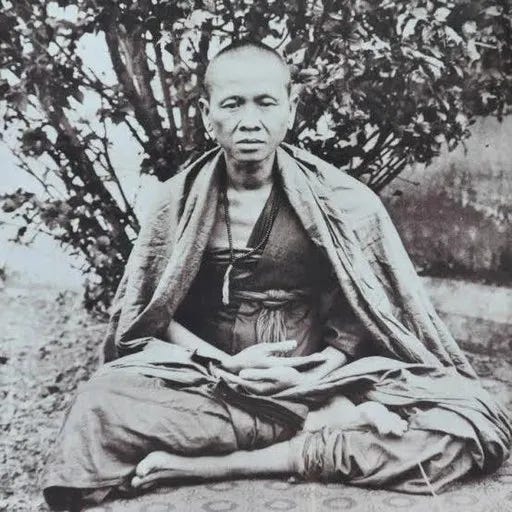
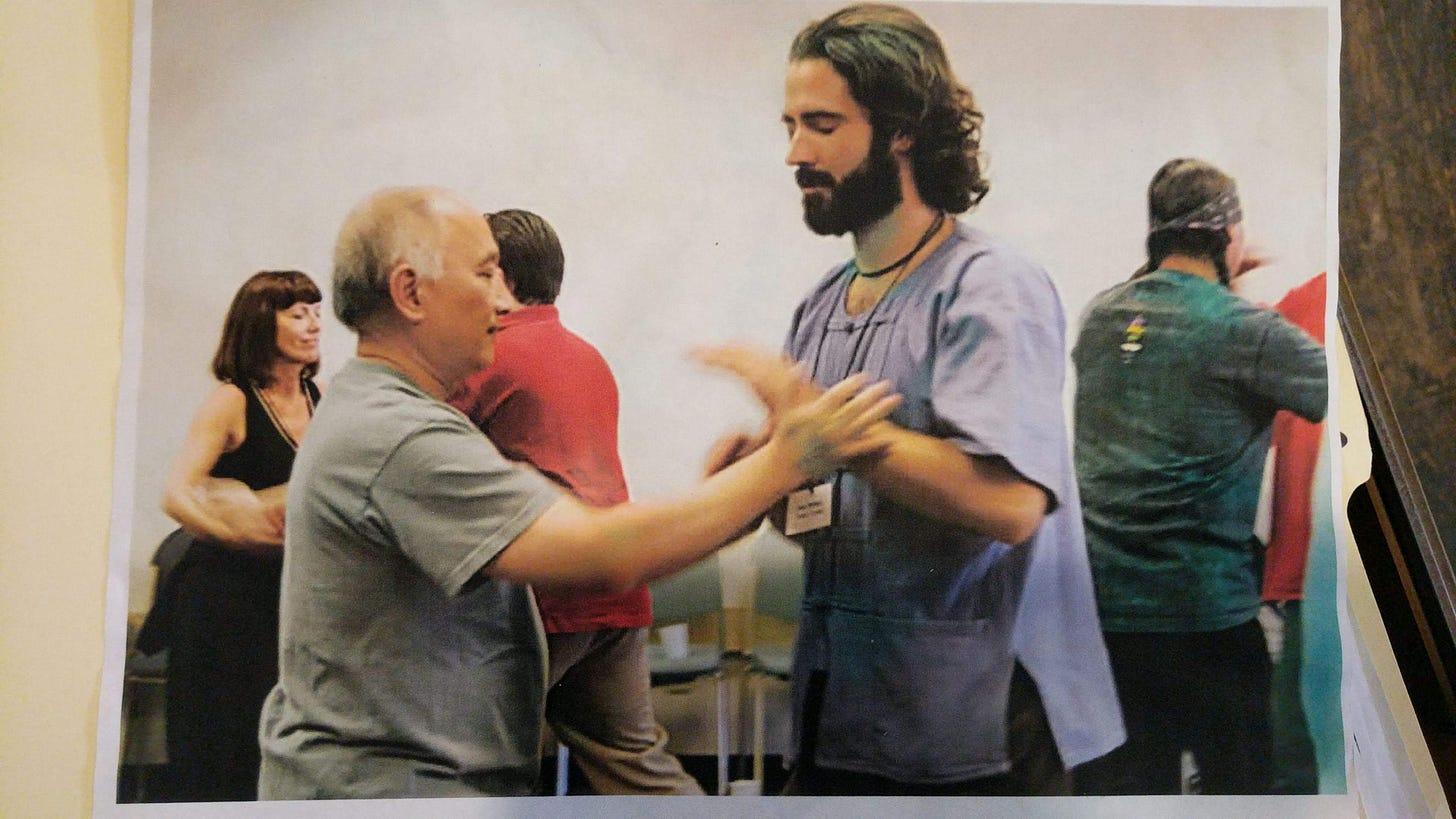
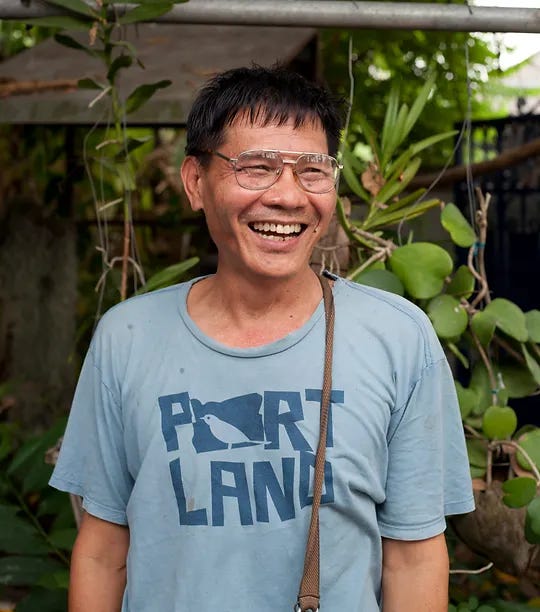
How lovely a tribute. xo